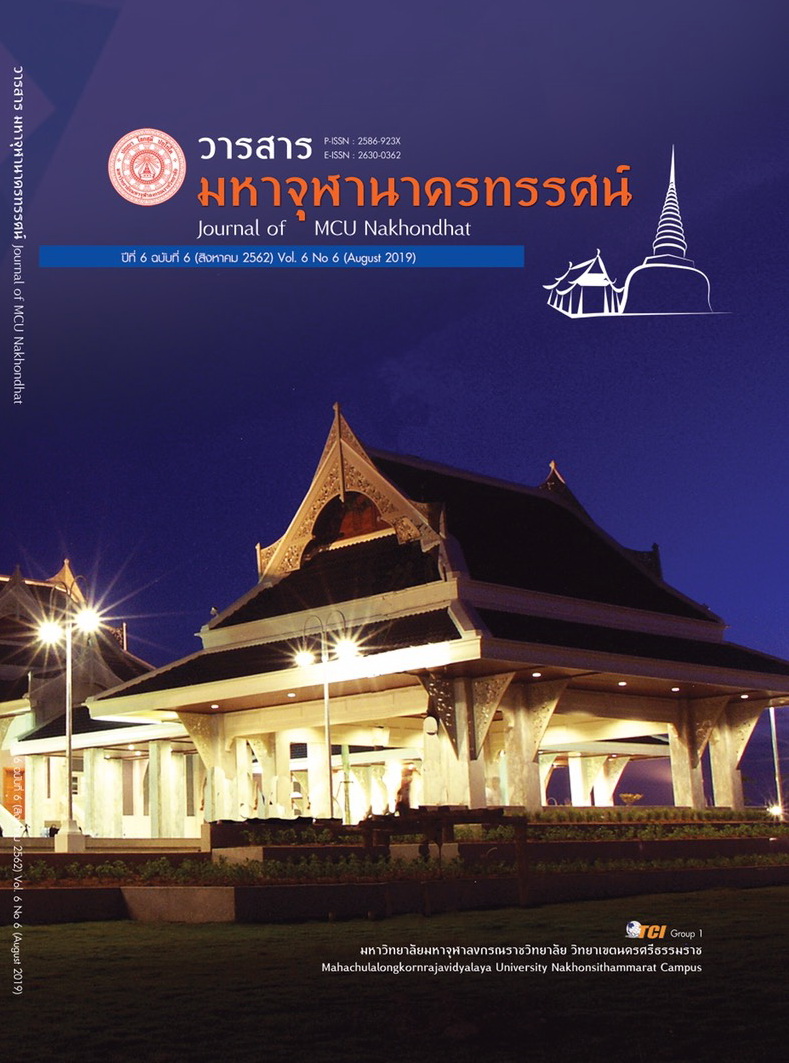THE FOUR FOUNDATIONS OF MINDFULNESS (SATIPAÑÑHÀNA) GUIDELINES FOR HEALING PATIENTS FROM DEPRESSION
Main Article Content
Abstract
The objectives of the study were 1) to study symptoms of the patients with the depressive disorder. 2) to study the four foundations of Mindfulness (Satipaññhàna) of the Buddhist sacred scriptures, and 3) to study the guidelines of four foundations of Mindfulness (Satipaññhàna) for healing the patients with the depressive disorder. This research is qualitative and collecting qualitative data from documents (Documentary Research), the Buddhist sacred scriptures, textbooks, books, the related research of this topic.
The results indicated that:
The depression was a mood disorder such as the feeling of sadness, unhappy, bored, dismal, dispirited, hopeless, drowsy, sleepless, bored with food, bad concentration, anxious and pessimistic. The symptoms of depression; there were some common signs to serious in moods as it was a mental health problem. Moreover, depression changed the way of thinking, feeling in daily activities that you used to like, and it can become a serious condition for harming one’s self. The medical care and Buddhism have classified it as a mental illness that has affected physically and mentally. The guidelines for the treatment of patients with depression, it may start on a treatment to mentally and mental health such as the middle way of moderation with emphasizing the brain, and body. In accordance with the four foundations of Mindfulness (Satipaññhàna) that has (Kàyànupassanà) the contemplation of the body, (Vedanànupassanà) the contemplation of feelings, Cittànupassanà) the contemplation of mind, (Dhammànupassanà) the Contemplation of Mind-object as a consequence of all able to heal the depression effectively. The results of this research showed many ways of practicing mindfulness such as walking meditation, focusing on mindful breathing meditation, perception states obtained by concentration and Mind-Object (Body) consideration, and Vipassana meditation. All of the meditation techniques for practicing mindfulness meditation were very useful.
Article Details
References
มหาจุฬาลงกรณราชวิทยาลัย. (2539). พระไตรปิฎกภาษาไทย ฉบับมหาจุฬาลงกรณราชวิทยาลัย. กรุงเทพมหานคร: โรงพิมพ์มหาจุฬาลงกรณราชวิทยาลัย.
รีดเดอร์ส ไดเจสท์. (2546). บำบัดโรคด้วยการแพทย์ทางเลือก. กรุงเทพมหานคร: รีดเดอร์ส ไดเจสท์.
ศิริลักษณ์ วรไวย์. (2557). การศึกษาธรรมโอสถในพระพุทธศาสนา. ใน วิทยานิพนธ์พุทธศาสตรมหาบัณฑิต สาขาพระพุทธศาสนา. มหาวิทยาลัยมหาจุฬาลงกรณราชวิทยาลัย.
สมเด็จพระมหาวีระวงศ์ (พิมพ์ ธมฺมธโร). (2540). อานุภาพแห่งกรรม. กรุงเทพมหานคร: สถาบันบันลือธรรม.
สมภพ เรืองตระกูล. (2548). จิตเวชศาสตร์. กรุงเทพมหานคร: เรือนแก้วการพิมพ์.
สายฝน เอกวรางกูร. (2553). รู้จัก เข้าใจ ดูแล ภาวะซึมเศร้า. กรุงเทพมหานคร: บริษัทสเอเชียเพรส จํากัด.
สำนักงานพัฒนาโครงการแนวทางการบริหารสาธารณสุข. (2549). แนวทางปฏิบัติบริการสาธารณสุข. กรุงเทพมหานคร: บริษัท กิตติชัย พริ้นติ้ง จํากัด.
สุชีพ ปุญญานุภาพ. (2539). พระไตรปิฎก ฉบับประชาชน (พิมพ์ครั้งที่ 16). กรุงเทพมหานคร: โรงพิมพ์มหากุฏราชวิทยาลัย.


